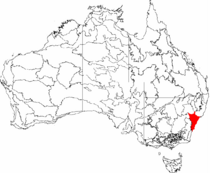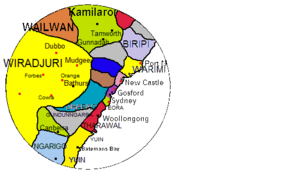Awabakal facts for kids
Quick facts for kids Awabakal people |
|
|---|---|
| aka: Awabagal, Awaba, Kuri, Minyowa, Minyowie | |

Mid North Coast bioregion
|
|
| Hierarchy | |
| Language family: | Pama–Nyungan |
| Language branch: | Yuin–Kuric |
| Language group: | Kuri |
| Group dialects: | Awabakal |
| Area (approx. 1,800 sq. km) | |
| Bioregion: | Mid North Coast |
| Location: | Mid North Coast, New South Wales |
| Coordinates: | 33°5′S 151°30′E / 33.083°S 151.500°E |
| Other geological: | Lake Macquarie |
| Notable individuals | |
| Biraban | |
The Awabakal people are an Aboriginal Australian group. They are connected to the coastal area of the Hunter Region in New South Wales. Their traditional lands stretched from Wollombi in the west. They also covered the Lower Hunter River near Newcastle and Lake Macquarie in the north.
Some people have used the name Kuringgai to describe the Awabakal and other nearby groups. However, experts like Norman Tindale and Arthur Capell have different ideas about this name. Some believe Kuringgai was the same as Awabakal. Others think it was a separate language and group.
Contents
What's in a Name? The Awabakal Meaning
In the Awabakal language, awaba means "flat or plain surface." This word was used for Lake Macquarie. So, the Awabakal people are named after this important lake.
The small town of Awaba in the region also gets its name from this word. The Awabakal lands were surrounded by other Aboriginal groups. The Wonnarua were to their north-west. The Worimi were to their north-east. The Darkinung peoples lived to the west and south.
Speaking the Awabakal Language

The Awabakal language is very important. It was written down by Lancelot Edward Threlkeld and Awabakal Leader Birabahn. Their book, 'An Australian grammar,' was the first detailed record of an Indigenous language in Australia.
Today, the City of Newcastle is teaching people about traditional language history. They are also using dual names for important places. Newcastle's traditional name is Muluubinba.
Here are some local places with their traditional Awabakal names:
- Whibayganba – Nobbys Headland
- Tahlbihn – Flagstaff Hill (Fort Scratchley)
- Burrabihngarn – Pirate Point (Stockton)
- Yohaaba – Port Hunter
- Coquun – Hunter River
- Khanterin – Shepherds Hill (The Hill)
- Toohrnbing – Ironbark Creek
- Burraghihnbihng – Hexham Swamp
Awabakal Country and Land
Experts estimate that the Awabakal traditional territory covers about 2870 square kilometres. This large area shows the deep connection the Awabakal people have to their land.
Traditional Ways and Practices
The eaglehawk, also known as the wedge-tailed eagle, is very special to the Awabakal people. They believe Kon, a "celestial entity," looks like an Aboriginal man but flies like an eagle-hawk.
The Awabakal people played a big role in shaping their environment. They used fire-stick farming to manage the land. This helped them hunt and move through thick coastal areas. Newcastle's main street, Watt Street, was built over an old Awabakal path. Fishing, especially for shellfish, was a key part of their food and culture.
Before European settlement, the Awabakal were known for protecting their land. They lived on their rich coastal territory for thousands of years. They successfully kept their land safe from other groups. They also had special places high in the Watagan Mountains for defence.
Awabakal People Today
Many Awabakal descendants are still connected to their traditional lands. They are the direct descendants of those who survived the early British settlement. These families work together through the Awabakal Descendants of the Traditional Owners Aboriginal Corporation.
These traditional owners have lived on and cared for the Awabakal land and water for a very long time. They have been there since at least the last Ice Age, about 11,800 years ago. Their strong connection to the land shows their amazing strength and ability to adapt.
They have also shown great kindness to other Aboriginal people who have settled in their area. This is a sign of their strong community spirit.
Organisations like 'The Awabakal Newcastle Aboriginal Cooperative Limited' support Aboriginal people in the region. This group started in 1976. It provides health and community services, including:
- the Awabakal Medical Centre
- the Awabakal Disability Service for young people
- culturally appropriate care for older people
- child care services
Protecting the Butterfly Cave
The Butterfly Cave near West Wallsend is a very important cultural site for women. It is linked to birthing and has been protected by women for decades. However, the site is on private land where new houses are being built.
Even though it is a protected site under Australian law, women still need permission to visit it. This shows the ongoing efforts to protect important cultural places.
Learning Centres
The Awabakal Environmental Education Centre started in 1976. It helps students and teachers learn about the environment. It also teaches about how humans interact with nature.
The Wollotuka Institute helps Indigenous people with university studies. It began in 1983 as a support program. In 2002, the all-Indigenous staff moved into their new building, Birabahn. The Wollotuka Institute officially opened in 2009.
Native Title Claims
In 2013, some Awabakal and Guringai descendants made a native title claim. This claim was for land from Maitland to Hornsby. Other Aboriginal groups, the Worimi and Wonnarua, disagreed with this claim.
In 2017, the claim was withdrawn. The government said that while the group showed they were descendants, they could not prove they had continuously followed their traditional laws and practices since European settlement.
Notable Awabakal People
- Biraban – He was a respected leader of the Awaba clan. He helped the Rev Lancelot Threlkeld create the first grammar book of an Aboriginal language in Australia.
Other Names for Awabakal
- Awaba (the name for Lake Macquarie)
- Awabagal
- Kuri (a general term for "man" in Sydney area languages)
- Kuringgai
- "Lake Macquarie, Newcastle" tribe
- Minyowa (an Awabakal group at Newcastle)
- Minyowie
See also

